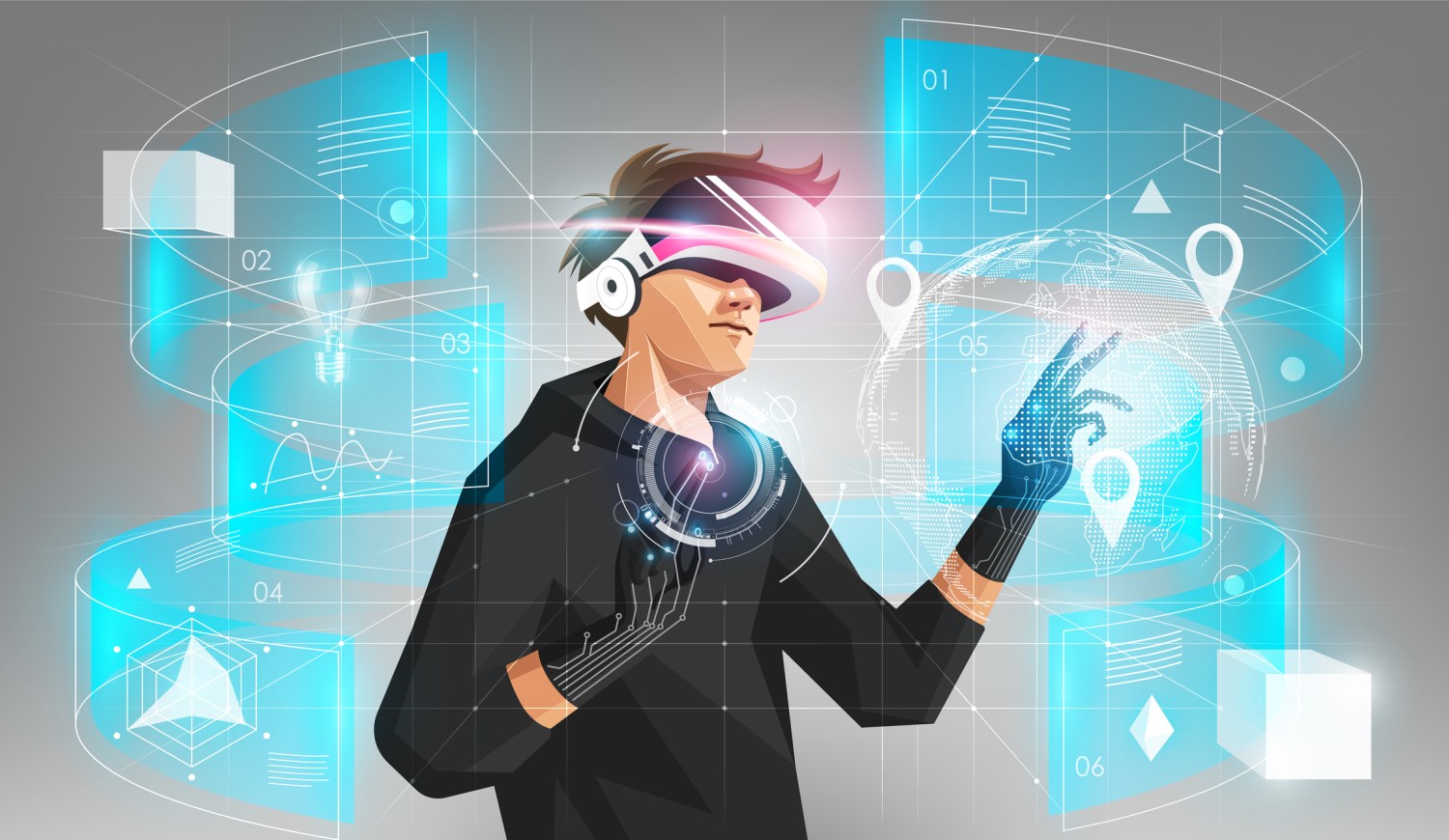From Online World to Metaverse
The future of online games and games research.
A Brief History
In the games field, we have had a long history of dealing with the challenges of online worlds concurrently used by many people – whether termed virtual worlds, MUDs (Multi-User Dungeons), MMOs (Massively Multiplayer Online games), or other acronyms, they have all shared at heart a few qualities:
- A simulation of physical space, of place, sometimes crude (“room” models akin to text adventures) and sometimes more sophisticated (fully navigable 3d environments).
- The representation of users via some form of an avatar
- Some amount of persistence, ranging from full persistent state for the entire environment, to limited to just the data for the avatars.
The history of online worlds and that of the concept of the metaverse have been intertwined from very early on; key developers of early worlds were science-fiction fans, and the early depictions of “cyberspace” in fiction were influential on developers of online games. Even the word “avatar” itself crossed back and forth, muddying the etymology of today’s usage.
Given how vague the definition of “metaverse” is, it’s worth looking at the signature features that are most commonly mentioned as ingredients of the metaverse. Among the features most often mentioned in fictional depictions are:
- A fully immersive world, rather than one on a screen. This has been depicted in various ways such as Star Trek’s Holodeck (first seen in the animated series in 1974), or the virtual reality (VR) goggles used to access the Oasis in Ernest Cline’s Ready Player One,1 and Neal Stephenson’s Snow Crash.6
- Overlaying virtual spaces onto real world landscapes via augmented reality (AR), as depicted in Vernor Vinge’s Rainbows End8 and Karl Schroeder’s Stealing Worlds (Schroeder, 2019).4
- Real world impacts such as economic ties between virtual and physical spaces, as shown in novels such as Cory Doctorow’s For the Win,2 and Charles Stross’ Halting State.7
- A multiplicity of fictional settings that users can easily switch or travel between using common technology which gives access to all of them. This feature is depicted in all of the above examples.
Even what today we think of as standalone games are increasingly meshed together via overarching systems such as Microsoft’s GamePass or Sony’s PlayStation Network.
Every single one of these features has been implemented in virtual worlds before, often quite long ago. VR virtual worlds such as VRChat (self-published by VRChat, 2014) or Rec Room (self-published by Rec Room, 2016) are quite popular as of this writing, meeting the “immersive world” criterion. Pokemon Go (Niantic, 2016) and its predecessor Ingress (Niantic, 2012) overlay virtual world games onto the real-world landscape as depicted in the novels with augmented reality games, albeit mostly via smartphones and not AR glasses. Economic impact between virtual and real worlds has been widespread since Ultima Online (Electronic Arts, 1997) and likely earlier, via players transacting in digital game items via real world marketplaces. Worlds supporting significant user-generated content such as Second Life (Linden Labs, 2003) and Metaplace (self-published by Metaplace Inc., 2009) enabled highly varied environments players could hop between using a standard piece of client software; the former in a continuous 3D map, and the latter via a more web-like hyperlink structure.
Even what today we think of as standalone games are increasingly meshed together via overarching systems such as Microsoft’s GamePass or Sony’s PlayStation Network. We have known for a long time that any game smaller than a virtual world can be embedded in a virtual world, using instancing.
So all of the key features of a metaverse have already existed in online worlds. But we don’t seem to perceive what we have today as “a metaverse.” It seems our technical definition of the metaverse has been expanding over time to stay ahead of implemented actuality.
A More Rigorous Definition
In 2006, a forecasting session was held at Stanford by the Acceleration Studies Foundation,5 including a set of invited participants from a wide array of fields including virtual world practitioners. The trends forecast there could be summarized as four strands:
- Virtual worlds in the MMO sense, which can be thought of as fictional worlds simulated on servers.
- Mirror worlds in the sense used by David Gelernter in Mirror Worlds,3 which can be described as subsets of our own non-fictional world, simulated on servers like a virtual world.
- Lifelogging, or the flow of data from an individual into a virtual identity
- Augmented realities, which take the form of data from the network annotating the real world, with the data filtered using a virtual “avatar” position updated on a remote server passively using global positioning service (GPS) data from a client device.
The underlying commonalities here are evident. We have simulations of worlds; whether the dataset simulated happens to be of non-fictional or fictional origin is irrelevant to the technology platform. We have digital identities; whether they happen to reflect real world data as in lifelogging (as in Facebook or Linkedin) or a fictional character history in a roleplaying game (RPG) is likewise irrelevant.
There are even direct analogies for the object data and virtual items that we interact with when we gather up a sword in an MMO: unique serial numbers, RFIDs (Radio Frequency Identification tags), and MAC addresses (the unique identifier every piece of hardware on a network uses) identify individual objects. Systems such as ASIN (Amazon Standard Identification Number), UPC (Universal Product Code, the barcodes on most product packaging), ISBN (International Standard Book Number, the barcode on the back of published books), ISRC (International Standard Recording Code, the unique identifier encoded into sound and music video recordings), and others identify object types, much like an entry in a game strategy guide might identify a particular magic sword as a common or rare drop.
To speak as a gamer for a moment: Facebook is just your RPG character sheet for your real-world avatar. Waze is just a driving MMO with a very simple client interface and not much of a game loop. There isn’t necessarily a difference between shopping using Yelp and a vendor search interface in an MMO. There are few elements of real-world life that we haven’t tried simulating in a virtual world at some point. We are, as a species, actively building databases that tum everything into, well, MMO data.
Seen in this light, one way to think of the metaverse is as a natural evolution of the dreams of virtual worlds we are quite familiar with, but which encompasses more and more data from the real world, on a common technical platform. The elements missing from fictional depictions mostly have to do with the unification of what are today very disparate platforms owned by different companies.
Will users have any rights guaranteed by governments, as opposed to click through Terms of Service? Or is the metaverse destined to be oppressive?
Red Herrings
Many people associate the metaverse specifically with virtual reality headsets, perhaps driven by fictional depictions in Snow Crash and Ready Player One. We can see this as a mistake akin to the assumption that smartphones would replace desktop PCs. Technology often accretes, rather than replaces. Desktop PCs have been a popular way to engage in computing since the days of the Apple II in 1977, and still account for a significant number of hours spent on computing devices per day. Simply put, there are use-cases for a desktop that a smartphone cannot handle. We can similarly predict that any vision of the metaverse that doesn’t include smartphones is probably wrong. Neither VR nor AR is likely to deliver better versions of everything that a smartphone does.
Any future vision of the metaverse must assume that it can and will be accessed via all the sorts of devices we commonly use, in whatever way best suits the user’s purpose. The core definitional qualities have to do with the server side data, not the client rendering capabilities.
The inescapable example is the Internet and the web itself, which thanks to standards allow us to hop between webpages that are vastly different, using a wide array of client devices. If our modem virtual worlds acquired the traits of the web such as common client and server technology and the ability to hop between varying content easily – including the non-fictional content! – we’d be at something that most of us would start to recognize from the fictional depictions.
Put another way: we have virtual worlds now. Interconnect them and allow users to transparently move between them, and we get a multiverse. Meld in the non-fictional use cases, and now we have a metaverse.
Any plausible path to a metaverse must also reckon with the increasing crossover between entertainment and social functions. Real world relationships and weddings have been around in online worlds for decades; we’ve seen countless online friendships become strong real-world connections. The flow of value between digital goods in games and real world currencies, which started with people selling in-game items in early MMOs on eBay, has only increased with time.
A Vision of a Future
In a full-fledged metaverse, there may be a virtual Machu Picchu that hosts real-world tourists who are physically there, seeing virtual annotations using AR glasses or just a phone. Their movements in physical space are updated to the servers in real time using GPS and spatial positioning technologies. At the same time, virtual tourists could see those same annotations from their desktop halfway around the world via VR or a large monitor, navigating the virtual space using a more game-like client. Both groups would be able to each see the other and interact in real time, because they are connected to the same servers.
Simultaneously, gamers might be running around the virtual Machu Picchu fighting creatures out of Incan mythology. They would be traversing the same map data as the tourists, as they draw from common geospatial data sources. Some of these gamers might be among the real-world tourists, covertly playing in the real world in an AR game, while others do it from home, in an MMO.
Digital artifacts could exist in the game servers, but also in the tourist servers – and might be bought as physical souvenirs by real tourists as well as acquired by the game players… and of course, would be “smart objects” that update their location to the server. This crossover between digital and physical goods would be made possible by serial numbers and unique identifiers that use a common standard; in fact, the players and tourists also use a common unique identifier that is referenced by both the game and tourist servers.
Put another way: a signature element of the metaverse is that you won’t be sure if you are in it, because it’ll just be the pervasive unification of all these trends. You, as avatar. Avatars, as people. Real world objects, as digital objects. Digital objects, as real as real things. Places that are real and imagined at the same time.
The web analogy allows us to see glimpses of this future. What happens when you are embodied in many worlds at once at the same time? We saw this on Metaplace, which ran in a browser and allowed players to have tabs open to many worlds at once. We may need to update our jargon from “telepresence” to “metapresence.”
As virtual worlds continue to proliferate and interconnect, we can hope that this path we are on continues to be pushed forward by a game-like ethos.
Research Considerations
As we move forward, there are several research considerations to keep in mind as the crossover between our digital and non-digital worlds continues to increase towards a “metapresence” future.
For example, in 2006, an interview event in Second Life was interrupted when a user generated a swarm of flying penises, leveraging the user-generated content tools of the platform. Only a couple of years later, a flying penis attack occurred in the real world using a drone, and many commentators referenced the Second Life incident.
The Corrupted Blood Plague of 2005 in World of Warcraft is another example. A bug in an update to the game resulted in a highly contagious “virus” spreading between player avatars, resulting in a “pandemic” lasting several weeks. This was then discussed by academics as a possible disease model applicable to real world epidemiology.
We will likely see versions of these incidents overlaid on our real world someday, via AR glasses. Every fun story we have read about bugs or misbehavior occurring in games such as Eve Online, Second Life, Ultima Online, or World of Warcraft will have metaverse equivalents occurring in the real world. They will have real economic impacts. They will open fresh legal questions like “who owns the virtual real estate rights for a given real world location.” They will change economies, affect public policy, and so on. All of these are fruitful areas for research.
The governance challenges are also pertinent; virtual worlds are perfect versions of Jeremy Bentham’s panopticon thought experiment, settings in which surveillance can be all-pervasive and unavoidable. Who will own the servers and the data they accumulate is a crucial question, as data traces of activity could be used for positive outcomes such as health tracking; commercial uses such as datamining populations for marketing purposes; and negative uses such as oppressive governments tracking dissidents. Will users have any rights guaranteed by governments, as opposed to click through Terms of Service? Or is the metaverse destined to be oppressive? These possibilities argue strongly against the idea of a single all-encompassing metaverse, if only to preserve the ability for users to leave.
All of these questions have been active areas of research in game studies since at least the early 1990s, as well as in fields such as sociology, anthropology, psychology, legal studies, and economics. We can anticipate that games research will find plenty of the same fruitful topics coming up again – just with a wider scope, and perhaps more pointed lessons for how we live our day to day lives.
For those frightened by these possibilities, there is a glimmer of hope. Entertainment has clearly been the major driver of adoption and innovation in the virtual world space throughout its now four-decade history, as at any given moment game worlds have drawn significantly larger populations than purely social worlds. Entertainment software innovation is deeply resistant to technological standardization in some ways, precisely because games and game technology rely so heavily on novelty, whereas standards tend to intentionally slow the rate of change. Operators of games are also obliged to be deeply pragmatic about their practices lest users abandon them en masse. These tendencies work against the idea of a single centralized metaverse put to nefarious uses.
As virtual worlds continue to proliferate and interconnect, we can hope that this path we are on continues to be pushed forward by a game-like ethos. The motives of pure technology companies may be driven by crass advertising and microtransaction plans, and games have certainly succumbed to the temptation of those business models in the past. But at least games are shaped by the desire to increase the world’s quotient of fun, of play, of creativity, and of the rich communities they form. That seems a better dream to aim for than the cyberpunk vision of a world where pop-up ads and corporate masters track our every step.
References
- Cline, E. Ready Player One. New York, NY: Crown Books (2001).
- Doctorow, C. For the Win. New York, NY: Tor Books (2010).
- Gelertner, D. Mirror Worlds: or the Day Software Puts the Universe in a Shoebox. How It Will Happen and What It Will Mean. Oxford, U.K. Oxford University Press (1991).
- Schroeder, K. Stealing Worlds. New York NY: Tor Books (2019).
Copyright
© 2023 Copyright held by the owner/author(s).
Share this story. Choose your platform.
Want more updates and information from ACM? Sign up for our Newsletter.
Related Articles

The Toxic Cost of Cheap Usernames
Toxicity in video games, acting in a rude, abusive, bullying, or deliberately losing manner, ruins competitive team-based video game experiences for everyone involved.
August 12, 2024,

What Are the Points of Concern for Players about VR Games
In recent years, the VR boom has signaled fruitful applications in fields such as education, industry, animation, and entertainment.
August 22, 2024,

An Empirical Study of VR Head-Mounted Displays Based on VR Games Reviews
In recent years, the VR tech boom has signaled fruitful applications in various fields.
August 22, 2024,

